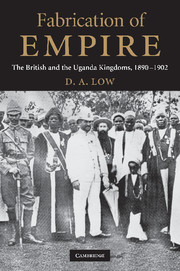Book contents
- Frontmatter
- Contents
- Preface
- List of abbreviations and locations
- Sketch maps
- 1 Prologue: survey and agenda
- 2 Statecraft: external intrusion and local dominion
- 3 Ferment: conversion and revolution in Buganda
- 4 Upcountry: might-have-beens and the Buganda/Uganda outcome
- 5 Warbands: new military formations and ground level imperialism
- 6 Paramountcy: Toro, Busoga and the new overlords
- 7 Defeat: Kabalega's resistance, Mwanga's revolt and the Sudanese mutiny
- 8 Succession: Nkore and the war of Igumira's eye
- 9 Dénouement: aggregations and rulerships
- 10 Government: colonial settlements and the Buganda model
- 11 Capstone: honour, awe and imperialism
- 12 Round up and review
- Select bibliography
- Index
11 - Capstone: honour, awe and imperialism
Published online by Cambridge University Press: 04 July 2009
- Frontmatter
- Contents
- Preface
- List of abbreviations and locations
- Sketch maps
- 1 Prologue: survey and agenda
- 2 Statecraft: external intrusion and local dominion
- 3 Ferment: conversion and revolution in Buganda
- 4 Upcountry: might-have-beens and the Buganda/Uganda outcome
- 5 Warbands: new military formations and ground level imperialism
- 6 Paramountcy: Toro, Busoga and the new overlords
- 7 Defeat: Kabalega's resistance, Mwanga's revolt and the Sudanese mutiny
- 8 Succession: Nkore and the war of Igumira's eye
- 9 Dénouement: aggregations and rulerships
- 10 Government: colonial settlements and the Buganda model
- 11 Capstone: honour, awe and imperialism
- 12 Round up and review
- Select bibliography
- Index
Summary
By 1901, a mere dozen years after the first intrusion by British imperialist agents, the foundations of the new, colonial polity of Uganda had thus been largely laid. The defining essentials of its fortuitously determined territorial dimensions had now been fixed. The heavy-handed and often totally arbitrary rejigging of the boundaries of the kingdom areas at its core, and the forced amalgamation of thirty and more previously relatively autonomous rulerships into a mere five had now been accomplished. In three of them, thanks to British intervention, the entrenchment of what had initially been highly problematic oligarchical revolutions appeared assured, while the relatively distinctive arrangements for colonial government which had eventually emerged in Buganda were taking on the form of a model which was being steadily replicated elsewhere.
The extensive countrywide acquiescence in these major innovations constituted one measure of the fact that British colonial hegemony was now well established. The varying dependence following the death or deposition of every significant immediately preceding pre-colonial ruler of the four remaining acknowledged monarchs upon the favour of the British for the security of their tenure provided a second, while the reorganisation, upon peacetime lines, of the mercenary troops the British employed – now redesignated as the 4th and 5th battalions of the King's African Rifles, the former 1,000 strong, composed of a variety of local recruits superseding numbers of Sudanese, the latter of 500 Indian troops – constituted a third.
- Type
- Chapter
- Information
- Fabrication of EmpireThe British and the Uganda Kingdoms, 1890–1902, pp. 318 - 332Publisher: Cambridge University PressPrint publication year: 2009



